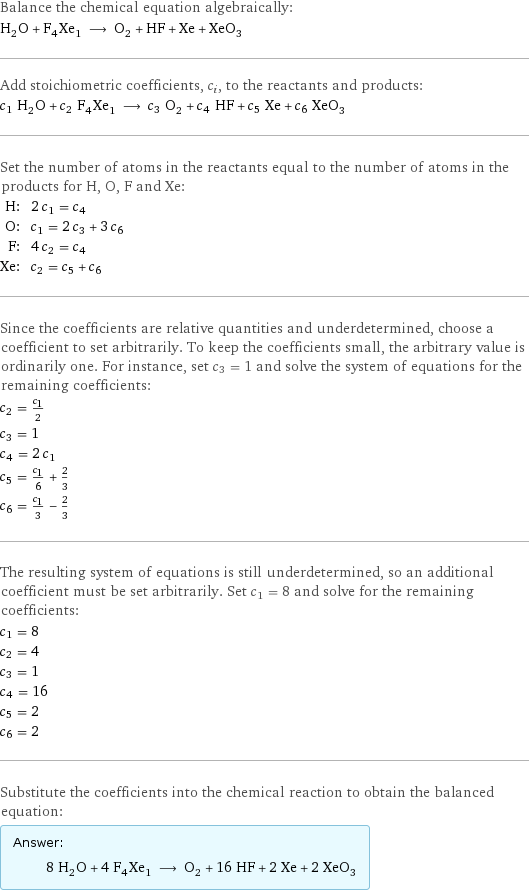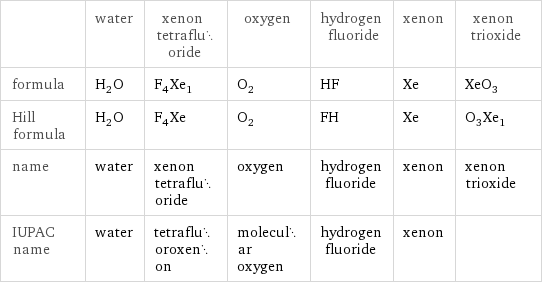Input interpretation

H_2O water + F_4Xe_1 xenon tetrafluoride ⟶ O_2 oxygen + HF hydrogen fluoride + Xe xenon + XeO_3 xenon trioxide
Balanced equation

Balance the chemical equation algebraically: H_2O + F_4Xe_1 ⟶ O_2 + HF + Xe + XeO_3 Add stoichiometric coefficients, c_i, to the reactants and products: c_1 H_2O + c_2 F_4Xe_1 ⟶ c_3 O_2 + c_4 HF + c_5 Xe + c_6 XeO_3 Set the number of atoms in the reactants equal to the number of atoms in the products for H, O, F and Xe: H: | 2 c_1 = c_4 O: | c_1 = 2 c_3 + 3 c_6 F: | 4 c_2 = c_4 Xe: | c_2 = c_5 + c_6 Since the coefficients are relative quantities and underdetermined, choose a coefficient to set arbitrarily. To keep the coefficients small, the arbitrary value is ordinarily one. For instance, set c_3 = 1 and solve the system of equations for the remaining coefficients: c_2 = c_1/2 c_3 = 1 c_4 = 2 c_1 c_5 = c_1/6 + 2/3 c_6 = c_1/3 - 2/3 The resulting system of equations is still underdetermined, so an additional coefficient must be set arbitrarily. Set c_1 = 8 and solve for the remaining coefficients: c_1 = 8 c_2 = 4 c_3 = 1 c_4 = 16 c_5 = 2 c_6 = 2 Substitute the coefficients into the chemical reaction to obtain the balanced equation: Answer: | | 8 H_2O + 4 F_4Xe_1 ⟶ O_2 + 16 HF + 2 Xe + 2 XeO_3
Structures

+ ⟶ + + + XeO_3
Names

water + xenon tetrafluoride ⟶ oxygen + hydrogen fluoride + xenon + xenon trioxide
Equilibrium constant
![Construct the equilibrium constant, K, expression for: H_2O + F_4Xe_1 ⟶ O_2 + HF + Xe + XeO_3 Plan: • Balance the chemical equation. • Determine the stoichiometric numbers. • Assemble the activity expression for each chemical species. • Use the activity expressions to build the equilibrium constant expression. Write the balanced chemical equation: 8 H_2O + 4 F_4Xe_1 ⟶ O_2 + 16 HF + 2 Xe + 2 XeO_3 Assign stoichiometric numbers, ν_i, using the stoichiometric coefficients, c_i, from the balanced chemical equation in the following manner: ν_i = -c_i for reactants and ν_i = c_i for products: chemical species | c_i | ν_i H_2O | 8 | -8 F_4Xe_1 | 4 | -4 O_2 | 1 | 1 HF | 16 | 16 Xe | 2 | 2 XeO_3 | 2 | 2 Assemble the activity expressions accounting for the state of matter and ν_i: chemical species | c_i | ν_i | activity expression H_2O | 8 | -8 | ([H2O])^(-8) F_4Xe_1 | 4 | -4 | ([F4Xe1])^(-4) O_2 | 1 | 1 | [O2] HF | 16 | 16 | ([HF])^16 Xe | 2 | 2 | ([Xe])^2 XeO_3 | 2 | 2 | ([XeO3])^2 The equilibrium constant symbol in the concentration basis is: K_c Mulitply the activity expressions to arrive at the K_c expression: Answer: | | K_c = ([H2O])^(-8) ([F4Xe1])^(-4) [O2] ([HF])^16 ([Xe])^2 ([XeO3])^2 = ([O2] ([HF])^16 ([Xe])^2 ([XeO3])^2)/(([H2O])^8 ([F4Xe1])^4)](../image_source/c6830b575cff931e4cca5aa3d0433a4c.png)
Construct the equilibrium constant, K, expression for: H_2O + F_4Xe_1 ⟶ O_2 + HF + Xe + XeO_3 Plan: • Balance the chemical equation. • Determine the stoichiometric numbers. • Assemble the activity expression for each chemical species. • Use the activity expressions to build the equilibrium constant expression. Write the balanced chemical equation: 8 H_2O + 4 F_4Xe_1 ⟶ O_2 + 16 HF + 2 Xe + 2 XeO_3 Assign stoichiometric numbers, ν_i, using the stoichiometric coefficients, c_i, from the balanced chemical equation in the following manner: ν_i = -c_i for reactants and ν_i = c_i for products: chemical species | c_i | ν_i H_2O | 8 | -8 F_4Xe_1 | 4 | -4 O_2 | 1 | 1 HF | 16 | 16 Xe | 2 | 2 XeO_3 | 2 | 2 Assemble the activity expressions accounting for the state of matter and ν_i: chemical species | c_i | ν_i | activity expression H_2O | 8 | -8 | ([H2O])^(-8) F_4Xe_1 | 4 | -4 | ([F4Xe1])^(-4) O_2 | 1 | 1 | [O2] HF | 16 | 16 | ([HF])^16 Xe | 2 | 2 | ([Xe])^2 XeO_3 | 2 | 2 | ([XeO3])^2 The equilibrium constant symbol in the concentration basis is: K_c Mulitply the activity expressions to arrive at the K_c expression: Answer: | | K_c = ([H2O])^(-8) ([F4Xe1])^(-4) [O2] ([HF])^16 ([Xe])^2 ([XeO3])^2 = ([O2] ([HF])^16 ([Xe])^2 ([XeO3])^2)/(([H2O])^8 ([F4Xe1])^4)
Rate of reaction
![Construct the rate of reaction expression for: H_2O + F_4Xe_1 ⟶ O_2 + HF + Xe + XeO_3 Plan: • Balance the chemical equation. • Determine the stoichiometric numbers. • Assemble the rate term for each chemical species. • Write the rate of reaction expression. Write the balanced chemical equation: 8 H_2O + 4 F_4Xe_1 ⟶ O_2 + 16 HF + 2 Xe + 2 XeO_3 Assign stoichiometric numbers, ν_i, using the stoichiometric coefficients, c_i, from the balanced chemical equation in the following manner: ν_i = -c_i for reactants and ν_i = c_i for products: chemical species | c_i | ν_i H_2O | 8 | -8 F_4Xe_1 | 4 | -4 O_2 | 1 | 1 HF | 16 | 16 Xe | 2 | 2 XeO_3 | 2 | 2 The rate term for each chemical species, B_i, is 1/ν_i(Δ[B_i])/(Δt) where [B_i] is the amount concentration and t is time: chemical species | c_i | ν_i | rate term H_2O | 8 | -8 | -1/8 (Δ[H2O])/(Δt) F_4Xe_1 | 4 | -4 | -1/4 (Δ[F4Xe1])/(Δt) O_2 | 1 | 1 | (Δ[O2])/(Δt) HF | 16 | 16 | 1/16 (Δ[HF])/(Δt) Xe | 2 | 2 | 1/2 (Δ[Xe])/(Δt) XeO_3 | 2 | 2 | 1/2 (Δ[XeO3])/(Δt) (for infinitesimal rate of change, replace Δ with d) Set the rate terms equal to each other to arrive at the rate expression: Answer: | | rate = -1/8 (Δ[H2O])/(Δt) = -1/4 (Δ[F4Xe1])/(Δt) = (Δ[O2])/(Δt) = 1/16 (Δ[HF])/(Δt) = 1/2 (Δ[Xe])/(Δt) = 1/2 (Δ[XeO3])/(Δt) (assuming constant volume and no accumulation of intermediates or side products)](../image_source/3840cda539c8a4c2b23cb87c31a9fee1.png)
Construct the rate of reaction expression for: H_2O + F_4Xe_1 ⟶ O_2 + HF + Xe + XeO_3 Plan: • Balance the chemical equation. • Determine the stoichiometric numbers. • Assemble the rate term for each chemical species. • Write the rate of reaction expression. Write the balanced chemical equation: 8 H_2O + 4 F_4Xe_1 ⟶ O_2 + 16 HF + 2 Xe + 2 XeO_3 Assign stoichiometric numbers, ν_i, using the stoichiometric coefficients, c_i, from the balanced chemical equation in the following manner: ν_i = -c_i for reactants and ν_i = c_i for products: chemical species | c_i | ν_i H_2O | 8 | -8 F_4Xe_1 | 4 | -4 O_2 | 1 | 1 HF | 16 | 16 Xe | 2 | 2 XeO_3 | 2 | 2 The rate term for each chemical species, B_i, is 1/ν_i(Δ[B_i])/(Δt) where [B_i] is the amount concentration and t is time: chemical species | c_i | ν_i | rate term H_2O | 8 | -8 | -1/8 (Δ[H2O])/(Δt) F_4Xe_1 | 4 | -4 | -1/4 (Δ[F4Xe1])/(Δt) O_2 | 1 | 1 | (Δ[O2])/(Δt) HF | 16 | 16 | 1/16 (Δ[HF])/(Δt) Xe | 2 | 2 | 1/2 (Δ[Xe])/(Δt) XeO_3 | 2 | 2 | 1/2 (Δ[XeO3])/(Δt) (for infinitesimal rate of change, replace Δ with d) Set the rate terms equal to each other to arrive at the rate expression: Answer: | | rate = -1/8 (Δ[H2O])/(Δt) = -1/4 (Δ[F4Xe1])/(Δt) = (Δ[O2])/(Δt) = 1/16 (Δ[HF])/(Δt) = 1/2 (Δ[Xe])/(Δt) = 1/2 (Δ[XeO3])/(Δt) (assuming constant volume and no accumulation of intermediates or side products)
Chemical names and formulas

| water | xenon tetrafluoride | oxygen | hydrogen fluoride | xenon | xenon trioxide formula | H_2O | F_4Xe_1 | O_2 | HF | Xe | XeO_3 Hill formula | H_2O | F_4Xe | O_2 | FH | Xe | O_3Xe_1 name | water | xenon tetrafluoride | oxygen | hydrogen fluoride | xenon | xenon trioxide IUPAC name | water | tetrafluoroxenon | molecular oxygen | hydrogen fluoride | xenon |